
If you have some knowledge of the IT development field or you are an expert, then you must have heard the name Golang. The language is relatively old, but its popularity has only gone up during the years due to its numerous benefits. Many businesses are considering switching to Golang after years of working with mainstream programming languages.
Developers around the world are struggling with developing cross-platform applications that seamlessly integrate with diverse operating systems. This is where Go comes in with its advanced features, such as the support for concurrency and parallelism. The language provides clever fixes and effectively resolves conventional complexities.
If you’re also interested in finding out why Go is so popular and what its benefits are, make sure to read through to the end!
What is the Go programming language (Golang)?
Popularly known as Go or Golang, the programming language was developed by Google to handle the advancing complexities in their codebases. It was released to the public in 2009 and has been a go-to choice for many since then due to its simplicity, readability, and efficiency.
It is one of the easiest programming languages to grasp and can be used to develop high-performing apps. It is a statically typed, concurrent, and garbage-collected open-source programming language.
Go distinguishes itself through its ingenious solutions to prevalent software development challenges. Its employment of goroutines and lightweight concurrent entities facilitates efficient multitasking without the complexities of traditional threading models. Moreover, Go’s package management system streamlines dependency handling, mitigating issues of uncontrolled dependencies and versioning conflicts.
Originally developed to be used in place of popular high-performance server-side languages like Java and C++, Go is now used for many different things, such as creating server-side or cloud-based applications, data science and artificial intelligence, and command line tools.
What is Golang used for?
Golang has successfully made its mark as an easy-to-use programming language. As a result, it is used for a variety of purposes:
Cloud-services
Cloud services are usually developed in Go due to its robust concurrency support, efficient performance, and scalability features. It provides on-demand access to shared computer processing so you can process your data on a private cloud or a third-party server.
Moreover, its efficient runtime and compilation speed contribute to faster execution, optimizing resource utilization within cloud infrastructures. This capability is pivotal for managing and servicing large-scale applications and distributed systems typical of cloud environments.
Back-end web development
When working on large-scale projects, choosing Go as your main back-end language is the best choice. It allows you to scale your project without worrying about how to on-board new developers while also simplifying the process of changing development teams if necessary. Additionally, you can maintain and update your software without difficulty if it has clear documentation and well-written code.
Real-time applications development
Go is an ideal programming language for developing real-time apps and other software, including online gaming, video conferencing software, instant messaging and chat apps, community storage solutions, and more.
Its robust concurrency support with goroutines and channels. Its high performance, efficient networking capabilities, and streamlined handling of streaming data make it an excellent choice for building responsive systems.
Microservices
Microservices are a service-oriented software architecture that divides an application into more minor services to make it simpler to comprehend, create, and test. Golang’s ability to create small, independent, and easily deployable services facilitates the development of resilient and loosely coupled microservice systems.
One of the prominent Go libraries supporting microservices development is the Go kit. It provides a set of tools, components, and abstractions explicitly designed for building microservices architectures in Go. It offers functionalities for handling service discovery, transport layers (HTTP, gRPC), request tracing, logging, and more.
Advantages of Golang
Golang has several benefits that significantly improve your development experience. A few of them are mentioned below:
Concurrency
Golang addresses concurrency like no other programming language while making it easy and tractable. Its built-in support for concurrency allows you to handle multiple tasks at the same time. The features also make the language ideal for building high-performance applications.
Goroutines, lightweight threads managed by Go runtime, are the main drivers of the concurrency model. They facilitate the execution of concurrent code, enabling the simultaneous execution of several functions. Goroutines are more memory-efficient than traditional threads because of their small memory requirements.
Low learning curve
Golang is known for its simplicity, which is also why many software engineers prefer it over other languages. Its simplicity makes it easy to learn, especially for developers who are already well-versed in languages like C and Java. Go’s procedural architecture is similar enough for developers to quickly adapt and understand, even though there may be variations in syntax and keywords.
Additionally, Go further reduces added complexity and promotes readability through its minimalist and concise syntax, which is easy to grasp. Its simplicity is also evident in its standard library and language constructs, which are designed to be intuitive and straightforward.
Cross-platform development
Cross-platform build creation in Go is one of a kind. Go eliminates this complexity, in contrast to many other languages where developers require a toolchain tailored to each target platform. It offers straightforward cross-compilation commands, saving developers a great deal of time and work.
With support for a broad spectrum of operating systems, from common ones like Windows and Linux to lesser-known platforms, Golang facilitates code portability and deployment ease. This uniformity in syntax and the ability to create executable binaries streamline the deployment process, empowering developers to reach diverse user bases effortlessly.
Scalable
Golang’s scalability owes much to its effective utilization of goroutines, which play a pivotal role in enabling concurrent programming. Goroutines offers a lightweight and efficient means to execute functions concurrently and independently within a Go program.
By employing goroutines, Golang facilitates the creation of concurrent, parallel tasks that can run simultaneously without excessive overhead. This concurrency support enhances scalability by allowing programs to efficiently utilize multi-core processors and distribute work across available resources.
Moreover, Golang’s complementary feature, channels, enables seamless communication and synchronization between goroutines, which ensures safe data exchange and coordination, further enhancing the language’s support for concurrent programming and scalability.
Programming tool support
Along with a number of essential packages that expand and improve the language, Golang provides an excellent standard library. There are a ton of other tools available to assist in developing low-code platforms, microservices, Go back-ends, and more. Some examples include:
- Gin – The Gin micro-framework is a powerful tool for building web applications and microservices.
- go – Best fit for projects that require routing.
- Revel – Used to develop application programming interfaces (APIs).
- Go Kit – Provides specialized support for microservices.
- Gorilla – A set of reusable components that come with a web/HTTP library.
Garbage collection
By automating memory management tasks, garbage collection in Go significantly reduces the burden on developers, leading to enhanced productivity and more reliable software. The garbage collector automates memory allocation and deallocation, sparing developers from manual memory management tasks prevalent in lower-level languages. This feature prevents memory leaks, a common issue in languages where memory deallocation isn’t handled automatically.
Disadvantages of Golang
While it is safe to say that the Go programming language has several benefits, some of its drawbacks are worth mentioning to our readers who are considering experimenting with Golang in their projects.
A few disadvantages of Golang include:
Time-consuming
Time consumption in Golang development can stem from various aspects, potentially impacting the development lifecycle. One factor contributing to this perception is the initial learning curve. Developers new to Golang might face a period of adaptation to its syntax, conventions, and unique features like concurrency models with goroutines and channels. This learning phase can extend the time required for project initiation and early development.
Lack of libraries
Being a relatively new language, Go lacks extensive library support, unlike its competitors, such as C and Java. Therefore, if you are looking to accomplish tasks that heavily depend on library support, then Go may not be the best choice. Additionally, you might also have to build certain functionalities from scratch, further affecting the deployment time and overall project.
Lack of generics
Generic functions are just like normal functions but with undefined types of inputs. Because Golang does not support generic functions, developers will need to write multiple blocks of code to use the same function with different kinds of inputs or parameters. This can significantly reduce development efficiency and impact code reusability.
Takeaway
In today’s era, when we are aided by programming languages, such as Python, which are not only descriptive but also offer complete functionality, it seems hard to go for older options, such as Go. However, there are still several benefits of using Golang in your projects, the most major one being its support for concurrency.
If you decide to choose Golang, don’t forget to properly consider its drawbacks, which include increased time consumption and lack of library support. Apart from this, the Go programming language is an ideal choice for developing large-scale applications and back-end development.





